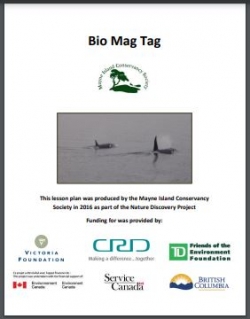Search for Resources
Description
This engaging tag based game visually illustrates the process of biomagnifcation and the movement of pollutants move through food chains. As students develop an awareness of how chemicals can accumulate and threaten the health of apex predators like Orca’s they will also begin to realize that humans also consume seafood which could contain the same toxins.
General Assessment
Recommendation of how and where to use it
This resource supports science units examining food chains and food webs, interactions in ecosystems and pollution impacts on the environment. The game can also be used to illustrate the connection between environmental health and human health. Pesticides are one example of a pollutant that can be reduced in ecosystems through citizen stewardship. A class could undertake a project that examines pesticide use in their community and develops a campaign to encourage citizens and municipal offices to switch to products that do not harm the environment.
Relevant Curriculum Units
The following tool will allow you to explore the relevant curriculum matches for this resource. To start, select a province listed below.
- Step 1Select a province
- Alberta
- British Columbia
- Step 2Select a grade level
- Grade 3
- Step 3Select a subject
- Science
- Step 4Relevant matches
- Science 3: Living things are diverse, can be grouped, and interact in their ecosystems
- Grade 4
- Step 3Select a subject
- Science
- Step 4Relevant matches
- Science 4: All living things sense and respond to their environment
- Manitoba
- New Brunswick
- Newfoundland & Labrador
- Northwest Territories
- Nova Scotia
- Nunavut
- Ontario
- Step 2Select a grade level
- Grade 4
- Step 3Select a subject
- Science & Technology
- Step 4Relevant matches
- Life Systems: Habitats and Communities
- Prince Edward Island
- Quebec
- Step 2Select a grade level
- Grade 3
- Step 3Select a subject
- Science & Technology
- Step 4Relevant matches
- Living Things
- Grade 4
- Step 3Select a subject
- Science & Technology
- Step 4Relevant matches
- Living Things
- Grade 5
- Step 3Select a subject
- Science & Technology
- Step 4Relevant matches
- Living Things
- Saskatchewan
- Yukon Territory
- Step 2Select a grade level
- Grade 3
- Step 3Select a subject
- Science
- Step 4Relevant matches
- Science 3: Living things are diverse, can be grouped, and interact in their ecosystems
- Grade 4
- Step 3Select a subject
- Science
- Step 4Relevant matches
- Science 4: All living things sense and respond to their environment
Themes Addressed
Ecosystems (1)
- Interdependence
Food & Agriculture (1)
- Pesticides
Human Health & Environment (1)
- Environmental Contaminants & Health Hazards
Water (1)
- Marine Environments

